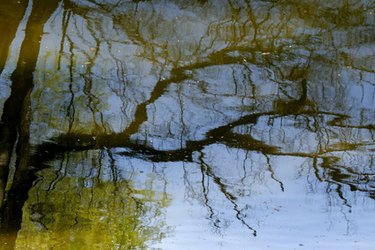Things You'll Need
Canvas or other background
Artist paints
Artist brushes
Photographic references

Paintings that represent scenes of nature and outdoors often contain elements of water. Things like lakes, rivers, streams and even the ocean can appear in the forefront or background of these paintings. Nature and water can be painted in any style from abstract to surrealist, though often is represented in impressionist and realist nature scenes. Create translucent clear water by distorting the ground and objects beneath the water and adding ripples of light, shadow and surface reflection. Use photographs of water, particularly in nature, as visual references to help guide you through the creative process.
Step 1
Paint the ground and objects that lay underneath the water in a distorted manner. These objects will be slightly abstracted in a rippled effect throughout the entire underwater area. Water's constant movement causes this optical effect, as the light hitting the objects is distorted. The objects and ground beneath the waters surface also have a hue that is slightly darker than the same objects and ground above the surface. Keep this in mind to help distinguish the water from the rest of the scene.
Video of the Day
Step 2
Paint areas of rippled shadows next to underwater objects. Add a small amount of black to the existing ground color mixture to create a shadow hue. The shadows created by these objects will have an abstracted rippled effect because of the existing light distortion caused by the water.
Step 3
Paint a definitive water edge. Create a distinct line where the top of the water meets the ground with an immediate shift to the darkened underwater hues. Distort the ground and objects beneath the water line along the edge and create areas of rippled light and shadow. Continue to enhance the edge by adding reflected light and objects across the surface of the water that begins at the water's edge.
Step 4
Add reflecting light and objects on the surface of the water to complete the overall translucent effect. Use pale colors, like that of the sky, and lightly apply in smooth rippled formations across the surface. Add faint puffs of rippling white in some areas to create reflecting clouds. Create direct sunlight by using bold and distinct areas of rippling light with a bright yellowish-white hue. Objects existing above the water and near its edge will also be reflected on the surface. Follow the rippled formations you have created on the water with the colors of your reflected objects using soft, but exaggerated strokes.
Video of the Day